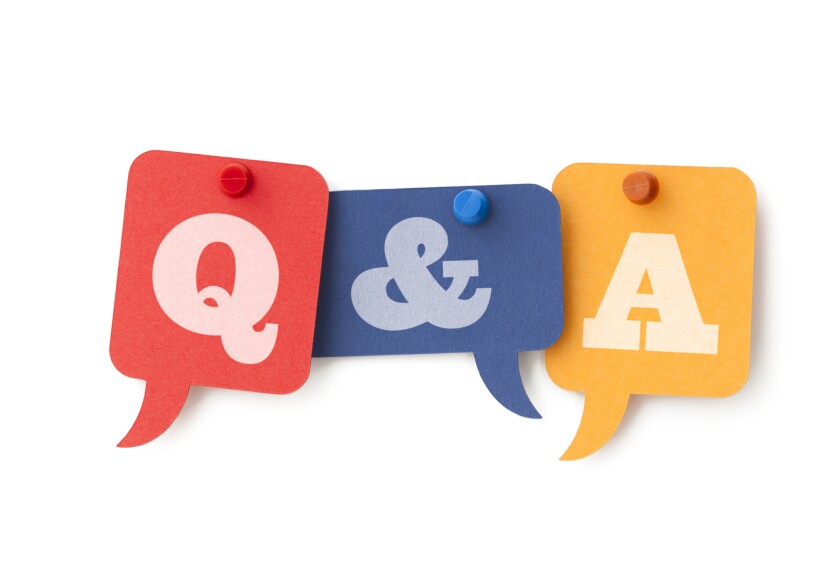When Kiki Leyba returned to teaching his English class at Columbine High School in the months following the infamous 1999 mass shooting, he found the tragedy was impossible to ignore.
Students arrived back at the Littleton, Colo., school with visible scars and wounds from the shooting, in which a pair of gunmen killed 12 students and a teacher and injured 21 others. One of his students was paralyzed and needed to use a wheelchair. Gregarious students turned timid. Previously well-behaved students became prone to outbursts, substance use, and misbehavior.
Leyba quickly realized he would need to address his and his students’ trauma head-on. He turned to his lesson plans.
“We were confronted with it on a daily basis. To ignore that is impossible,” Leyba said during a July 24 panel on gun violence at the American Federation of Teachers convention here. “I feel fortunate as an English teacher [because] writing was really significant in the classroom for us. Students who didn’t want to talk about it could write about it. Students who wanted to process it more could do that.”
The writing exercises taught Leyba and his students how to communicate about their shared trauma, which was unique to them at the time. On a good day, students were able to read their writing out loud and process the shooting with each other, Leyba said.
Twenty-five years after the Columbine shooting, Leyba’s experience is not so unique. In fact, the Columbine shooting is now widely recognized as the start of the modern era of the school shooter.
There have been 413 school shootings since 1999, according to the Washington Post. So far in 2024, there have been 21 school shootings with injuries or deaths, according to Education Week’s school shooting tracker.
Leyba joined Abbey Clements, who taught 2nd grade at Sandy Hook Elementary School in Newtown, Conn., when a gunman killed 20 students and six adults in 2012, to talk about teachers’ experiences with gun violence at the AFT convention.
Clements co-founded Teachers Unify to End Gun Violence, a nonprofit focused on raising awareness of gun violence’s impact on schools, alongside Sari Beth Rosenberg, a high school U.S. history teacher in New York City who moderated the AFT panel.
Despite the growing number of school shootings, teachers are often left to their own devices in the aftermath of such tragedies, Leyba and Clements said. It’s up to them to forge a path forward for their students, even as they’re grappling with their own trauma.
Teachers discover how to learn through tragedy
Clements struggled with how to teach following the Sandy Hook shooting. Some students wanted to talk about it constantly, while others refused to talk at all. One student came up to Clements daily and asked, “Where’s Miss Soto?” referring to Victoria Leigh Soto, one of the teachers killed in the shooting.
Clements followed advice she heard from experts to stick to a routine in her classroom and at home, but she knew her students needed an outlet. Like Leyba, she turned to writing.
Giving journals to her entire class, she instructed students to write about whatever they wanted, related to the tragedy or not. She told them she would use her own journal to write about her experience in the shooting.
Over a decade later, Clements has heard from her students and other school shooting survivors that having the opportunity to process their feelings through journaling, art, or music was key to moving beyond the tragedy.
Even in schools that haven’t experienced a mass shooting, it’s important to give students the space to express their feelings, Rosenberg said.
After the 2018 shooting at Marjory Stoneman Douglas High School in Parkland, Fla., Rosenberg’s students organized a walkout to show solidarity with Parkland students. Some teachers worried that students would use it as an opportunity to skip class, but every student made a point to return at the end, Rosenberg said.
Rosenberg also found her students wanting to vent and discuss their emotions following a 2022 mass shooting in a Brooklyn subway, in which a gunman shot 10 people, according to the New York Times.
“Whether there’s an incident in your school community or not, there are teachers in classrooms across America with kids who are looking to us to either fix it or, if we can’t fix it for them, help them in some way,” Rosenberg said. “I don’t know how to make sense of it. I don’t think we should, but we need to provide spaces for them.”
Teachers turn to activism
Leyba and his colleagues thought Columbine would be a standalone tragedy.
“Most of us believed we wouldn’t see anything like that again,” he said. “Of course, we did. Now we recognize that the violence has become normalized.”
Still a teacher at Columbine High School, he tells every class of new students that he survived the 1999 shooting and is open to talking about it. But even as the tragedy hangs over his career as a teacher, Leyba said he’s seen little change in efforts to prevent gun violence.
Frustration with a lack of action has spurred teachers like Leyba, Clements, and Rosenberg to move to activism, but it’s not always easy to speak up.
“There are places that you can go and talk to administration and leadership and they are willing to support you, and other places where it’s not going to happen,” Leyba said.
Clements, who is taking a leave of absence from teaching to serve as the executive director of Teachers Unify, said it can be difficult for teachers to advocate for gun violence prevention even if they’ve experienced a mass shooting.
“Activism, believe it or not, is difficult to do even in a place that is now defined by that tragedy,” Clements said. “There were times where I was worried about what the parents might think if they caught me on the news. That fear is definitely real.”
The feeling that teachers don’t have a voice when it comes to gun violence is what prompted Rosenberg and Clements to launch Teachers Unify in November 2021. The organization, also co-founded by Sarah Lerner, a teacher who survived the Parkland shooting, hosts a podcast, webinars, and in-person events to amplify teachers’ voices.
In addition to calling on Congress to reinstate a federal assault weapons ban, the group has published resources for teachers to help them care for students following tragedies or threats of gun violence. It advocated for the U.S. Department of Education to encourage schools to send letters home to families about safe firearm storage. In January, the Education Department released a template letter for this purpose.
“Before anything happens, make sure the conversations [about gun violence] are happening,” Clements said.
Disclaimer: The copyright of this article belongs to the original author. Reposting this article is solely for the purpose of information dissemination and does not constitute any investment advice. If there is any infringement, please contact us immediately. We will make corrections or deletions as necessary. Thank you.







